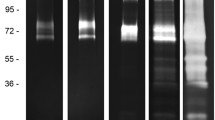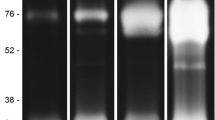Abstract
Oral inoculation of entomopoxvirus spindles, microstructures composed of fusolin protein, causes disruption of the peritrophic matrix (PM), a physical barrier against microbe infection, in the insect midgut. Although the atomic structure of fusolin has been determined, little has been directly elucidated of the mechanism of disruption of the PM. In the present study, we first performed an immunohistochemical examination to determine whether fusolin acts on the PM directly or indirectly in the midgut of Bombyx mori larvae that were inoculated with spindles of Anomala cuprea entomopoxvirus. This revealed that the PM, rather than the midgut cells, was the attachment site for fusolin. Fusolin broadly attached to the PM from the anterior to the posterior region, both to its ectoperitrophic and endoperitrophic surfaces and within the PM. These results likely explain why the whole of the PM is rapidly disintegrated. Second, we administered protease inhibitors mixed with spindles and observed decreased midgut protease activity and reduced disruption of the PM. This suggests that midgut protease(s) is also positively involved in PM disruption. Based on the present results, we propose an overall mechanism for the disruption of the PM by administration of fusolin.




Similar content being viewed by others
References
Arif BM (1995) Recent advances in the molecular biology of entomopoxviruses. J Gen Virol 76:1–13
Boucias DG, Pendland JC (1988) Principles of insect pathology. Kluwer, Norwell
Chakraborty M, Narayanan K, Sivaprakash MK (2004) In vivo enhancement of nucleopolyhedrovirus of oriental armyworm, Mythimna separata using spindles from Helicoverpa armigera entomopoxvirus. Indian J Exp Biol 42:121–123
Chiu E, Hijnen M, Bunker R, Boudes M, Rajendran C, Aizel K, Olieric V, Schulze-Briese C, Mitsuhashi W, Young V, Ward VK, Bergoin M, Metcalf P, Coulibaly F (2015) Structural basis for the enhancement of virulence by viral spindles and their in vivo crystallization. Proc Natl Acad Sci USA 112:3973–3978
Derksen ACG, Granados RR (1988) Alteration of a lepidopteran peritrophic membrane by baculoviruses and enhancement of viral infectivity. Virology 167:242–250
Din N, Damude HG, Gilkes NR, Miller RC Jr, Warren RAJ, Kilburn DG (1994) C1-Cx revisited: Intramolecular synergism in a cellulase. Proc Natl Acad Sci USA 91:11383–11387
Din N, Gilkes NR, Tekant B, Miller RC, Warren AJ, Kilburn DG (1991) Non-hydrolytic disruption of cellulose fibres by the binding domain of a bacterial cellulose. Nat Biotechnol 9:1096–1099
Furuta Y, Mitsuhashi W, Kobayashi J, Hayasaka S, Imanishi S, Chinzei Y, Sato M (2001) Peroral infectivity of non-occluded viruses of Bombyx mori nucleopolyhedrovirus and polyhedrin-negative recombinant baculoviruses to silkworm larvae is drastically enhanced when administered with Anomala cuprea entomopoxvirus spindles. J Gen Virol 82:307–312
Harper MS, Granados RR (1999) Peritrophic membrane structure and formation of larval Trichoplusia ni with an investigation on the secretion patterns of a PM mucin. Tissue Cell 31:202–211
Harper MS, Hopkins TL (1997) Peritrophic membrane structure and secretion in European corn borer larvae (Ostrinia nubilalis). Tissue Cell 29:463–475
Hopkins TL, Harper MS (2001) Lepidopteran peritrophic membranes and effects of dietary wheat germ agglutinin on their formation and structure. Arch Insect Biochem Physiol 47:100–109
Hukuhara T, Hayakawa T, Wijonarko A (2001) A bacterially produced virus enhancing factor from an entomopoxvirus enhances nucleopolyhedrovirus infection in armyworm larvae. J Invertebr Pathol 78:25–30
Kawakita H, Miyamoto K, Wada S, Mitsuhashi W (2016) Analysis of the ultrastructure and formation pattern of the peritrophic membrane in the cupreous chafer, Anomala cuprea (Coleoptera: Scarabaeidae). Appl Entomol Zool 51:133–142
Lehane MJ (1997) Peritrophic matrix structure and function. Annu Rev Entomol 42:525–550
Li X, Barrett J, Pang A, Klose RJ, Krell PJ, Arif BM (2000) Characterization of an overexpressed spindle protein during a baculovirus infection. Virology 268:56–67
Liu X, Ma X, Lei C, Xiao Y, Zhang Z, Sun X (2011) Synergistic effects of Cydia pomonella granulovirus GP37 on the infectivity of nucleopolyhedroviruses and the lethality of Bacillus thuringiensis. Arch Virol 156:1707–1715
Mitsuhashi W, Asano S, Miyamoto K, Wada S (2014) Further research on the biological function of inclusion bodies of Anomala cuprea entomopoxvirus, with special reference to effect on the insecticidal activity of a Bacillus thuringiensis formulation. Pest Manag Sci 70:46–54
Mitsuhashi W, Furuta Y, Sato M (1998) The spindles of an entomopoxvirus of Coleoptera (Anomala cuprea) strongly enhance the infectivity of a nucleopolyhedrovirus in Lepidoptera (Bombyx mori). J Invertebr Pathol 71:186–188
Mitsuhashi W, Kawakita H, Murakami R, Takemoto Y, Saiki T, Miyamoto K, Wada S (2007) Spindles of an entomopoxvirus facilitate its infection of the host insect by disrupting the peritrophic membrane. J Virol 81:4235–4243
Mitsuhashi W, Miyamoto K (2003) Disintegration of the peritrophic membrane of silkworm larvae due to spindles of an entomopoxvirus. J Invertebr Pathol 82:34–40
Mitsuhashi W, Miyamoto K, Wada S (2014) The complete genome sequence of the Alphaentomopoxvirus Anomala cuprea entomopoxvirus, including its terminal hairpin loop sequences, suggests a potentially unique mode of apoptosis inhibition and mode of DNA replication. Virology 452–453:95–116
Mitsuhashi W, Sato M, Hirai Y (2000) Involvement of spindles of an entomopoxvirus (EPV) in infectivity of the EPVs to their host insect. Arch Virol 145:1465–1471
Mukawa S, Nakai M, Okuno S, Takatsuka J, Kunimi Y (2003) Nucleopolyhedrovirus enhancement by a fluorescent brightener in Mythimna separata (Lepidoptera: Noctuidae). Appl Entomol Zool 38:87–96
Peters W (1992) Peritrophic membranes. Springer, Berlin
Shapiro M, Robertson JL (1992) Enhancement of gypsy moth (Lepidoptera: Lymantriidae) baculovirus activity by optical brighteners. J Econ Entomol 85:1120–1124
Takemoto Y, Mitsuhashi W, Murakami R, Konishi H, Miyamoto K (2008) The N-terminal region of an entomopoxvirus fusolin is essential for the enhancement of peroral infection, whereas the C-terminal region is eliminated in digestive juice. J Virol 82:12406–12415
Vaaje-Kolstad G, Horn SJ, van Aalten DMF, Synstad B, Eijsink VGH (2005) The non-catalytic chitin-binding protein CBP21 from Serratia marcescens is essential for chitin degradation. J Biol Chem 280:28492–28497
Vaaje-Kolstad G, Westereng B, Horn SJ, Liu Z, Zhai H, Sørlie M, Eijsink VGH (2010) An oxidative enzyme boosting the enzymatic conversion of recalcitrant polysaccharides. Science 330:219–222
Villares A, Moreau C, Bennati-Granier C, Garajova S, Foucat L, Falourd X, Saake B, Berrin J-G, Cathala B (2017) Lytic polysaccharide monooxygenases disrupt the cellulose fibers structure. Sci Rep 7:40262
Wang P, Granados RR (1997) An intestinal mucin is the target substrate for a baculovirus enhancin. Proc Natl Acad Sci USA 94:6977–6982
Wang P, Granados R (2001) Molecular structure of the peritrophic membrane (PM): identification of potential PM target sites for insect control. Arch Insect Biochem Physiol 47:110–118
Wijonarko A, Hukuhara T (1998) Detection of a virus enhancing factor in the spheroid, spindle, and virion of an entomopoxvirus. J Invertebr Pathol 72:82–86
Yaman M, Acar KF, Radek R (2015) A nucleopolyhedrovirus from the Mediterranean flour moth, Ephestia kuehniella (Lepidoptera: Pyralidae). Appl Entomol Zool 50:355–359
Yamazaki H (1955) Studies on the peritrophic membrane of Lepidopterous insects. Bull Nagano Seric Exp Stn 10:269–335 (in Japanese with English summary)
Acknowledgements
We thank Dr. Takumi Kayukawa and Ms. Chihiro Ueno at our institute for their support with some of the experiments. This work was supported in part by JSPS KAKENHI 26450474.
Author information
Authors and Affiliations
Corresponding author
Ethics declarations
Conflict of interest
All authors declare no conflicts of interest.
Additional information
Handling Editor: T. K. Frey.
Electronic supplementary material
Below is the link to the electronic supplementary material.
Rights and permissions
About this article
Cite this article
Mitsuhashi, W., Shimura, S., Miyamoto, K. et al. Spatial distribution of orally administered viral fusolin protein in the insect midgut and possible synergism between fusolin and digestive proteases to disrupt the midgut peritrophic matrix. Arch Virol 164, 17–25 (2019). https://doi.org/10.1007/s00705-018-4013-5
Received:
Accepted:
Published:
Issue Date:
DOI: https://doi.org/10.1007/s00705-018-4013-5




